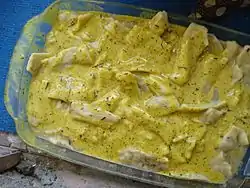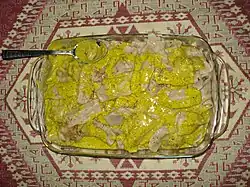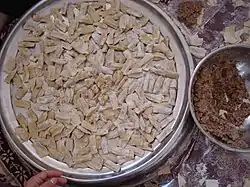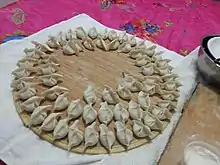Aush jushpare
Aush jushpare (آش جوش پَره) is a type of aush (Iranian thick soup/stew), commonly cooked in Khorasan, Gonabad, Ferdous and Sabzevar in Iran. It is similar to the Chinese jiaozi. Historian Bayhaqi (-1077) mentioned about Aush Jushpare in his book "Tarikh-i Bayhaqi". Aush Jushpare is one of the oldest Aush, but since it takes a lot of time for preparation, it is not commonly eaten now. It is rather a dish of hospitality, which people eat on the occasion of special gatherings or festivals. Traditional guest house restaurant serves Aush Jushpare as local specialty. Aush Jushpare was registered as intangible heritage of Iran on 5 January 2021.[1][2]
 Ash Jushpare | |
| Alternative names | Āsh, Aash |
|---|---|
| Type | Soup |
| Place of origin | Khorasan |
| Region or state | |
| Serving temperature | hot |
| Main ingredients | vegetables, broth, chaka |
| Variations | ash-e anar (pomagrante stew), ash-e-jo (barley stew), ash-e doogh (yogurt soup), ash-e sak (spinach stew). |



Ingredients
Aush is typically made with a variation of ingredients but may include; flat wheat noodles, turmeric, vegetables (broccoli, carrots, onion, celery, spinach, garlic, jalapeño), legumes (chickpeas, kidney beans), herbs (dill, mint, coriander, minced cilantro), yogurt and ground lamb, beef or chicken.[3][4][5][6]
As a dish prepared at home, each family has its own preferred method of making them, using favorite fillings, with types and methods of preparation varying from city to city. usually in Gonabad people do not add meat to the aush but some add the dumpling meat fillings include, mutton, beef, chicken, which are usually mixed with chopped beans, peas and onions vegetables. Some families add other popular vegetable fillings like napa cabbage, scallion (spring onions), leek, celery, spinach, mushroom, edible black fungus, carrot, and garlic chives, but the main ingredients for jushpare are beans, peas and onions.[7]
How to cook aush jushpare


First, knead flour with water to make a dough. Broaden a small piece of the dough to make a thin leaf shape, and put chopped stir-fried onions, pre-cooked lentils and peas, spices, Wrap it into the shape of triangle or quadrangle so that it does not open. This is called Jushpare (similar to samosa, dumplings or ravioli). Then put the Jushpare into boiling water, simmer it well, (about 35 minutes), and it is ready to eat. Before eating, add a little powdered cashk (dried fermented milk).
In recent days, pre-boiled Jushpare or Aush is available in stores. Also, some people fry Jushpare in oil.
Aush in Iranian cuisine
There are more than 50 types of thick soup (aush)or Aash in Iranian cooking, ash reshteh being one of the more popular types.[3] Some other well known āsh include ash-e anar (pomegranate stew), ash-e-jo (barley stew), ash-e doogh, ash-e sak (spinach stew), ash-e torsh (beet/pickle stew). The Iranian variation of aush often is topped with a garnish (na’na dagh) of fried mint oil, garlic chips, and/or shallot chips.[3][4]
Depending on the type of aush, it could contain different types of grain, legumes (chick peas, black-eye beans, lentils), vegetables, tomato, turnips (Aush-e-Shalqham), herbs (parsley, spinach, dill, spring onion ends, coriander, dried mint), onions, oil, meat, garlic, reshteh (in Ash Reshteh) and spices, such as salt, pepper, turmeric, saffron, etc.
Aush can be considered a full meal or a first course.[4] Aush can often be bought in Persian stores canned,[8] as dried mixes or frozen.
Since Aush is a very basic food in Iran, it became the etymology of words related to cooking. The word "cook" is "AushPaz" in Persian which is combination of "Aush" and "Paz", and literally means "a person who cooks Aush". Also the word "kitchen" is "AushPaz Khaneh": the combination of "AushPaz" and "Khaneh" which means house.[9]
See also
Sources
- "جوش پره و نان تفتون گناباد در فهرست آثار معنوی کشور به ثبت رسید" [Gonabad Taftoon Booth and Bread Boiler was registered in the list of spiritual works of the country]. ایرنا (in Persian). Jan 6, 2021.
- آش جوشپره، مجله دریای پارس، parssea، 1394 [Joshpareh soup, Persian Sea Magazine]
- "Ash-Reshteh (Persian New Years Noodle Soup) Recipe". Follow Me Foodie. 21 March 2013. Retrieved 2016-03-26.
- "Āsh 'eh Anar, Pomegranate soup". Fig & Quince. Archived from the original on 2016-04-08. Retrieved 2016-03-26.
- Starkey, Joanne (1990-08-05). "DINING OUT; A New Taste (Afghani) in Huntington". The New York Times. ISSN 0362-4331. Retrieved 2017-05-31.
- Cook, Karla (2012-12-14). "A Review of Afghan Kabob Fusion, in Franklin Park". The New York Times. ISSN 0362-4331. Retrieved 2017-05-31.
- M.Ajam, Jila (2015). Aash JushPare a Persian kitchen : old food in Iranian cooking. gonabad: parssea. p. 15.
- "Persian barley soup". Amazon.com. Retrieved 2016-03-25.
- Dana-Haeri, Jila (2014). From a Persian kitchen : fresh discoveries in Iranian cooking. London: I.B.Tauris. pp. 117–118. ISBN 9781780768014. OCLC 859880780.